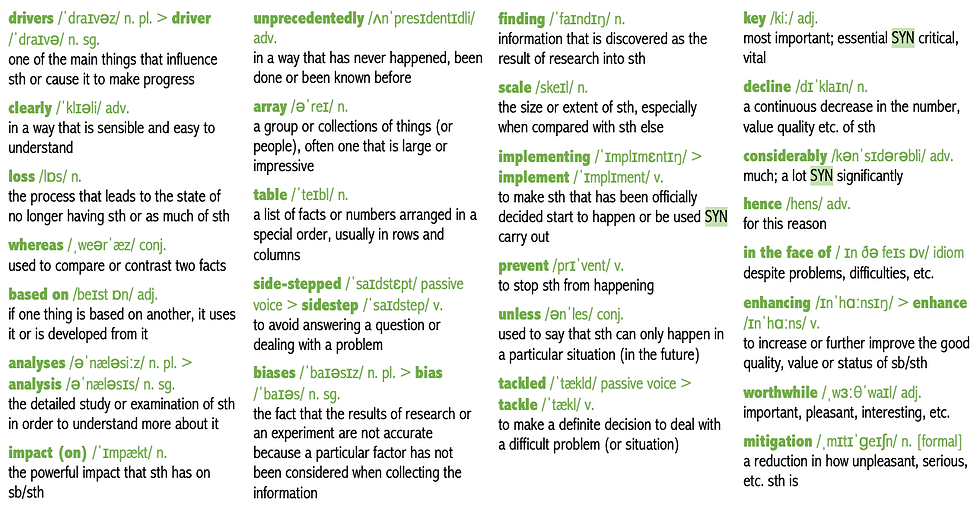The direct drivers of recent global anthropogenic biodiversity loss
- idiomgraphic

- Nov 23, 2022
- 3 min read
Updated: Nov 25, 2022

By Pedro Jaureguiberry et al.
Science Advances, Vol. 8, Issue 45
Excerpt of the Discussion section
We have shown clearly that land/sea use change—mainly in the form of rapid expansion and intensifying management of land used for cropping or animal husbandry (9)—and direct exploitation—mostly through fishing, logging, hunting, and wildlife trade (9)—have been the two dominant drivers of global biodiversity loss overall over recent decades (Fig. 1A). Whereas previous comparisons of driver importance have been based on either very few indicators or expert judgment, our analyses have robustly synthesized scientific knowledge on the relative impacts of multiple direct drivers on an unprecedentedly wide array of indicators of the state of biodiversity (table S1). They also include tests of consistency among the main geographic regions, types of ecosystems, and dimensions of biodiversity. By focusing on comparisons of two or more drivers, we have side-steppedbiases caused by unequal research attention among them (18) and by underreporting of small effects (25). Climate change is probably the most rapidly intensifying threat to biodiversity, and its impacts are increasingly well quantified (26), but other threats are still doing more damage.
This finding highlights the scale of the challenge facing those who are negotiating and implementing the post-2020 global biodiversity framework of the CBD. Combating climate change alone will not be enough to prevent—or possibly even slow—the further loss of biodiversity, unless damaging land/sea use change and direct exploitation are also tackled with similar ambition and determination (14, 27). Rapidly upscaling holistic management practices that benefit both climate and biodiversity will be key (5, 28) and must be done in a manner that safeguards livelihoods and ways of life (29, 30). Actions that succeed in reversing or slowing biodiversity declines can not only considerably slow human-caused climate change (31): They can also make ecosystems more able to maintain functionality—and hence the flows of nature’s contributions to people—in the face of ongoing climatic and other environmental changes (29). Enhancing this capability is itself a worthwhile goal, given the inevitability of ongoing climate change for at least decades, the limited state of knowledge of the complex ways it will interact with the other direct drivers, and the potential contribution of biodiversity to climate adaptation and mitigation (5, 32).

Given the need to tackle direct drivers in a holistic way, it is concerning that targets in current global environmental agreements—such as the CBD and the UN Framework Convention on Climate Change (UNFCCC)—are defined in isolation. The risk of this framing is that a narrow focus on one driver can lead to actions that overlook—and in the worst case undermine—targets on others (5). For instance, some “nature-blind” strategies for mitigating climate change include large-scale expansion of cropland bioenergy, but the resulting loss of natural habitat will directly harm biodiversity (33) and is already among the pressures with fastest-growing impacts (34). Even considering the benefit of reduced climate change, the net impact on biodiversity is likely to be negative (5, 33, 35). By contrast, nature-based solutions such as large-scale restoration of natural forest (36) and effective protection of coastal wetlands (37) not only help to mitigate climate change but also can directly provide additional benefits to biodiversity and people (5, 38).

The significantly different hierarchy in the ocean (Fig. 1B) suggests that, at the broadest scale, policies, strategies, and action targets for marine conservation need to emphasize direct exploitation and climate change more—and land/sea use change less—than their equivalents for the terrestrial and freshwater realms. The scale at which oceans are currently managed to reduce marine defaunation because of overfishing does not adequately match the great mobility of organisms at sea (39). Many of these disperse across multiple management jurisdictions, and the mean size of marine protected areas is much smaller than the home range size of most species. This mismatch may make it easier for these organisms to be affected by fishing operations, either directly when they are overfished or indirectly through bycatch. Although climate change is reshuffling marine ecological communities, high colonization potential helps many species to shift their geographical distribution across wider spatial scales than species on land (40). Climate change also has a particularly important impact on indicators of community composition on land and in fresh water (Fig. 3), but our analysis shows that changes in data-rich EBV classes are all strongly driven by land/sea use change, pointing to its major role across the various dimensions of biodiversity. The impact of direct exploitation on species populations is unsurprising but may, in part, reflect an understandable data bias toward populations and species that are being actively exploited.

Discussion: Academic Writing Tip
Restate the research question, hypothesis or objective, but avoid simply repeating the «Introduction»
Summarise the central results
Link these findings to other available research
Reflect on the limitations of the present study
State the broader social, political, ethical, etc. implications of these findings
Suggest follow-up research which is now necessary
Source: Academic Writing (F. Macgilchrist 2014)
Discussion: Useful phrases for opening lines
The excerpt shows the first four paragraphs of the Discussion. Here are some alternative opening lines:
This work is the first research testing ...
Previous studies have shown that (...) However, these studies are primarily concerned with (...)
We used (...) and assessed a novel hypothesis regarding (...) Specifically, we suggested that (...)
Source: Academic Writing (F. Macgilchrist 2014)



Comments